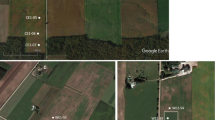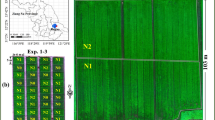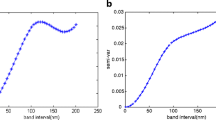Abstract
A comparison of the sensitivity of canopy scale estimators of leaf chlorophyll, obtainable with Sentinel-2 spectral resolution, to soil, canopy and leaf mesophyll factors, was addressed. The analysis of a synthetic dataset, generated simulating the reflectance in the 1–4 LAI range of canopies for the main general classes of leaf inclination (i.e. erectophile, plagiophile, spherical, planophile and extremophile) and for different soil types was used for such a purpose. The synthetic dataset was obtained using the PROSPECT5-4SAIL model in the direct mode with a large variety of soil backgrounds. Additionally an experimental dataset including airborne hyperspectral data gathered during ESA (European Space Agency) campaigns SPARC and AGRISAR, was employed to simulate Sentinel-2 spectral and spatial resolution, to confirm model results. Analysis of the synthetic and experimental datasets indicated that: (i) the CVI (Chlorophyll Vegetation Index), relying only on visible and NIR (Near Infra-Red) bands and obtainable at 10 m spatial resolution, can be used as leaf chlorophyll estimator, at growth stages suitable for nitrogen fertilizer topdressings, for all canopy structures except for erectophile canopies; (ii) better results can be obtained by using different indices for different leaf architectures, with TCI/OSAVI (Triangular Chlorophyll Index/Optimized Soil Adjusted Vegetation Index) performing better for erectophile canopies, whereas MTCI (MERIS Terrestrial Chlorophyll Index) provides better results for planophile canopies, despite the fact that these indices require bands obtainable at 20 m spatial resolution from Sentinel-2 data.




Similar content being viewed by others
References
Alonso, L., Moreno, J. (2005). Geometric and radiometric quality analysis of airborne images acquired in SPARC. In Proceedings of the SPARC Workshop. ESA, Enschede,The Netherlands CD-ROM WPP-250. ISSN 1022-6656.
Atzberger, C. (2004). Object-based retrieval of biophysical canopy variables using artificial neural nets and radiative transfer models. Remote Sensing of the Environment, 93, 53–67.
Bacour, C., Jacquemoud, S., Leroy, M., Hautecoeur, O., Weiss, M., Prévot, L., et al. (2002a). Reliability of the estimation of vegetation characteristics by inversion of three canopy reflectance models on airborne POLDER data. Agronomie Agriculture and Environment, 22(6), 555–565.
Bacour, C., Jacquemoud, S., Tourbier, Y., Dechambre, M., & Frangi, J.-P. (2002b). Design and analysis of numerical experiments to compare four canopy reflectance models. Remote Sensing of the Environment, 79, 72–83.
Baret, F., Hagolle, O., Geiger, B., Bicheron, P., Miras, B., Huc, M., et al. (2007a). LAI, fAPAR and fCover CYCLOPES global products derived from VEGETATION. Remote Sensing of the Environment, 110, 275–286.
Baret, F., Houles, V., & Gue, M. (2007b). Quantification of plant stress using remote sensing observations and crop models: the case of nitrogen management. Journal of Experimental Botany, 58(4), 869–880.
Baret, F., Weiss, M., Bicheron, P., Berthelot, B. (2010). Sentinel-2 MSI products WP1152 Algorithm Theoretical Basis Document for product group B. Version 2.1., INRA/ESA Report Sentinel-2 Products Algorithms.
Campbell, G. (1990). Derivation of an angle density function for canopies with ellipsoidal leaf angle distributions. Agricultural and Forest Meteorology, 49(3), 173–176.
Casa, R., Castaldi, F., Pascucci, S., & Pignatti, S. (2015). Chlorophyll estimation in field crops: an assessment of handheld leaf meters and spectral reflectance measurements. Journal of Agricultural Science, 153, 876–890.
Casa, R., & Jones, H. G. (2005). LAI retrieval from multiangular image classification and inversion of a ray tracing model. Remote Sensing of the Environment, 98, 414–428.
Ciganda, V. S., Gitelson, A. A., & Schepers, J. (2012). How deep does a remote sensor sense? Expression of chlorophyll content in a maize canopy. Remote Sensing of the Environment, 126, 240–247.
Dash, J., & Curran, P. J. (2001). The MERIS terrestrial chlorophyll index. International Journal Remote Sensing, 25(23), 5403–5413.
Daughtry, C. S. T., McMurtrey, J. E, I. I. I., Kim, M. S., & Chappelle, E. W. (1997). Estimating crop residue cover by blue fluorescence imaging. Remote Sensing of the Environment, 60(1), 14–21.
Daughtry, C. S. T., Walthall, C. L., Kim, M. S., Brown de Colstoun, E., & McMurtrey, J. E, I. I. I. (2000). Estimating corn leaf chlorophyll concentration from leaf and canopy reflectance. Remote Sensing of the Environment, 74(2), 229–239.
De Wit, C.T. (1965). Photosynthesis of leaf canopies. Agr. Res. Report 663, PUDOC, Wageningen, The Netherlands.
Delegido, J., Alonso, L., González, G., & Moreno, J. (2010). Estimating chlorophyll content of crops from hyperspectral data using a normalized area over reflectance curve (NAOC). International Journal of Applied Earth Observation and Geoinformation, 12, 165–174.
ESA (European Space Agency) (2015). Sentinel-2A Spectral Response Functions (S2A-SRF). COPE-GSEG-EOPG-TN-15-0007. Retirieved September 2015 from https://earth.esa.int/documents/247904/685211/Sentinel-2A+MSI+Spectral+Responses.
Féret, J. B., François, C., Asner, G. P., Gitelson, A. A., Martin, R., Bidel, L. P. R., et al. (2008). PROSPECT-4 and 5: Advances in the leaf optical properties model separating photosynthetic pigments. Remote Sensing of the Environment, 112(6), 3030–3043.
François, C., Ottlé, C., Olioso, A., Prévot, L., Bruguier, N., & Ducros, Y. (2002). Conversion of 400–1100 nm vegetation albedo measurements into total shortwave broadband albedo using a canopy radiative transfer model. Agronomie, 22(6), 611–618.
Gandìa, S., Moreno, J., Fernàndez, G., Moreno, D. (2005). Chlorophyll measurements in SPARC campaigns. In: Proceedings of the SPARC Workshop. ESA, Enschede,The Netherlands CD-ROM WPP-250. ISSN 1022-6656.
German Aerospace Center (DLR), (2007). AGRISAR 2006 agricultural bio-/geophysical retrievals from frequent repeat sar and optical imaging. final report. 19974/06/I-LG. Retirieved September 2015 from https://earth.esa.int/web/guest/campaigns.
Gitelson, A. A., Kaufman, J. Y., & Merzlyac, M. N. (1996). Use of a Green channel in remote sensing of global vegetation from EOS-MODIS. Remote Sensing of the Environment, 58, 289–298.
Gitelson, A. A., Keydan, G. P., & Merzlyac, M. N. (2006). Three-band model for noninvasive estimation of chlorophyll, carotenoids, and anthocyanin contents in higher plant leaves. Geophysical Research Letters, 33, L11402.
Gitelson, A. A., Vina, A., Ciganda, V., Rundquist, D. C., & Arkebauer, T. J. (2005). Remote estimation of canopy chlorophyll content in crops. Geophysical Research Letters, 32(8), L08 403.1–L08 403.4.
Guanter, L., Richter, R., Alonso, L., Moreno, J. (2005). Atmospheric correction algorithm for remote sensing data over land. ii. application to ESA SPARC campaigns: airborne sensors. In Proceedings of the SPARC Workshop. ESA, Enschede,The Netherlands CD-ROM WPP-250. ISSN 1022-6656.
Haboudane, D., Tremblay, N., Miller, J., & Vigneault, P. (2008). Remote estimation of crop chlorophyll content using spectral indices derived from hyperspectral data. IEEE Transactions Geoscience Remote Sensing, 46(2), 423–437.
Jacquemoud, S., Bacour, C., Poilve, H., & Frangi, J. P. (2000). Comparison of four radiative transfer models to simulate plant canopies reflectance: direct and inverse mode. Remote Sensing of the Environment, 74(3), 471–481.
Jacquemoud, S., Baret, F., Andrieu, B., Danson, M., & Jaggard, K. (1995). Extraction of vegetation biophysical parameters by inversion of the PROSPECT + SAIL models on sugar beet canopy reflectance data. Application to TM and AVIRIS sensors. Remote Sensing of the Environment, 52, 163–172.
Jacquemoud, S., Verhoef, W., Baret, F., Bacour, C., Zarco-Tejada, P. J., Asner, G. P., et al. (2009). PROSPECT + SAIL models: A review of use for vegetation characterization. Remote Sensing of the Environment, 113, S56–S66.
Koetz, B., Baret, F., Poilvé, H., & Hill, J. (2005). Use of coupled canopy structure dynamic and radiative transfer models to estimate biophysical canopy characteristics. Remote Sensing of the Environment, 95, 115–124.
Samborski, S. M., Tremblay, N., & Fallon, E. (2009). Strategies to make use of plant sensors-based diagnostic information for nitrogen recommendations. Agronomy Journal, 101(4), 800–816.
Solari, F., Shanahan, J. F., Ferguson, R. B., & Adamchuk, V. I. (2010). An active sensor algorithm for corn nitrogen recommendations based on a chlorophyll meter algorithm. Agronomy Journal, 102(4), 1090–1098.
Varella, H., Guérif, M., & Buis, S. (2010). Global sensitivity analysis measures the quality of parameter estimation: the case of soil parameters and a crop model. Environmental Modelling and Software, 25, 310–319.
Verhoef, W. (1997). Theory of radiative transfer models applied in optical remote sensing of vegetation canopies. Ph.D. Thesis. Wageningen Agricultural University, The Netherlands.
Verhoef, W., Xiao, Q., Jia, L., & Su, Z. (2007). Unified optical-thermal four-stream radiative transfer theory for homogeneous vegetation canopies. IEEE Transactions on Geoscience and Remote Sensing, 45(6), 1808–1822.
Vincini, M., Amaducci, S., & Frazzi, E. (2014). Empirical estimation of leaf chlorophyll density in winter wheat canopies using Sentinel-2 spectral resolution. IEEE Transactions on Geoscience and Remote Sensing, 52, 3220–3235.
Vincini, M., & Frazzi, E. (2011). Comparing narrow and broad-band vegetation indices to estimate leaf chlorophyll content in planophile crop canopies. Precision Agriculture, 12(3), 334–344.
Vincini, M., & Frazzi, E. (2013). Portability of leaf chlorophyll empirical estimators obtained at Sentinel-2 spectral resolution. In J. V. Stafford (Ed.), Precision agriculture’13, proceedings of the 9th European conference on precision agriculture (pp. 151–157). The Netherlands: Wageningen Academic Publishers.
Vincini, M., Frazzi, E., & D’Alessio, P. (2008). A broad-band leaf chlorophyll vegetation index at the canopy scale. Precision Agriculture, 9(5), 303–319.
Acknowledgments
RC would like to thank the European Space Agency (ESA) for the provision of SPARC and AGRISAR campaign data under the Category-1 Proposal 17972.
Author information
Authors and Affiliations
Corresponding author
Rights and permissions
About this article
Cite this article
Vincini, M., Calegari, F. & Casa, R. Sensitivity of leaf chlorophyll empirical estimators obtained at Sentinel-2 spectral resolution for different canopy structures. Precision Agric 17, 313–331 (2016). https://doi.org/10.1007/s11119-015-9424-7
Published:
Issue Date:
DOI: https://doi.org/10.1007/s11119-015-9424-7




